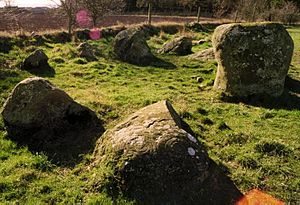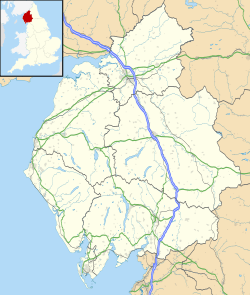Little Meg facts for kids

The Little Meg circle with the decorated stone in the foreground
|
|
| Location | Little Salkeld |
|---|---|
| Coordinates | 54°43′50″N 2°39′30″W / 54.73064°N 2.65845°W |
| Type | Kerb cairn |
| History | |
| Periods | Bronze Age |
Little Meg is an ancient site in Cumbria, England. It is also known as the Maughanby circle. This site is a small circle of large stones. These stones likely surrounded a Bronze Age (about 2,500 to 700 BC) kerb cairn. A kerb cairn is a mound of stones, often covering a burial.
Little Meg is near the village of Langwathby. It is north-east of Penrith. It sits about 650 meters north-east of a much larger and more famous stone circle. That site is called Long Meg and Her Daughters. Little Meg is part of a group of old stone circles and cairns in the area.
Contents
Where is Little Meg Located?
Little Meg is found about 650 meters north-east of the Long Meg stone circle. It sits on a small ridge. From Little Meg, people could probably see Long Meg when it was in use long ago.
Many ancient stone circles and monuments in this area are near old travel routes. For example, the Shap Stone Avenue is along a main route. The Long Meg complex, including Little Meg, is near the River Eden. Other sites like Mayburgh Henge are close to the River Eamont.
How Was Little Meg Built?
When Little Meg was first found in the 1800s, a mound of earth about 1.3 meters high covered the stones. Reports varied on how many stones were there. Some said 8, others 11. This difference might be because the mound still covered some stones.
Inside the circle, archaeologists found interesting things. They discovered bones, charcoal, and a simple pot. These items were buried in a stone box called a cist at the center of the circle. The pot was plain and stood at one end of the cist.
It is also a question whether the stones were standing upright or lying down. Some people think that some stones might have been pushed over before the mound was built. If there were 11 stones, the circle would have been about 18 feet across. The stone mound inside might have been part of the original design.
Ancient Rock Art at Little Meg
One special stone at Little Meg has ancient carvings on it. These carvings show a spiral shape connected to many circles, one inside another. The lines are very clear. This suggests the carvings were made just before the mound covered them. The mound would have helped protect the artwork over time.
There was another carved stone on the west side of the circle. It had a carved circle and other marks. This stone is not there anymore.
Two other stones were found inside the cist. These are now in the Penrith Museum. They have special "cup and ring" markings. These are small hollows (cups) surrounded by carved rings. We are not sure what these stones were used for in the cist. They might have held up a capstone, which is a large flat stone on top.
When Was Little Meg Used?
Even though Little Meg looks like a small stone circle, it was most likely a Bronze Age (around 2,500 to 700 BC) kerb cairn. This means it was a burial mound with a stone border. Another similar mound was found about 100 yards east of Little Meg. This was noted by Canon Simpson, who first recorded Little Meg.
See also
 In Spanish: Little Meg para niños
In Spanish: Little Meg para niños


